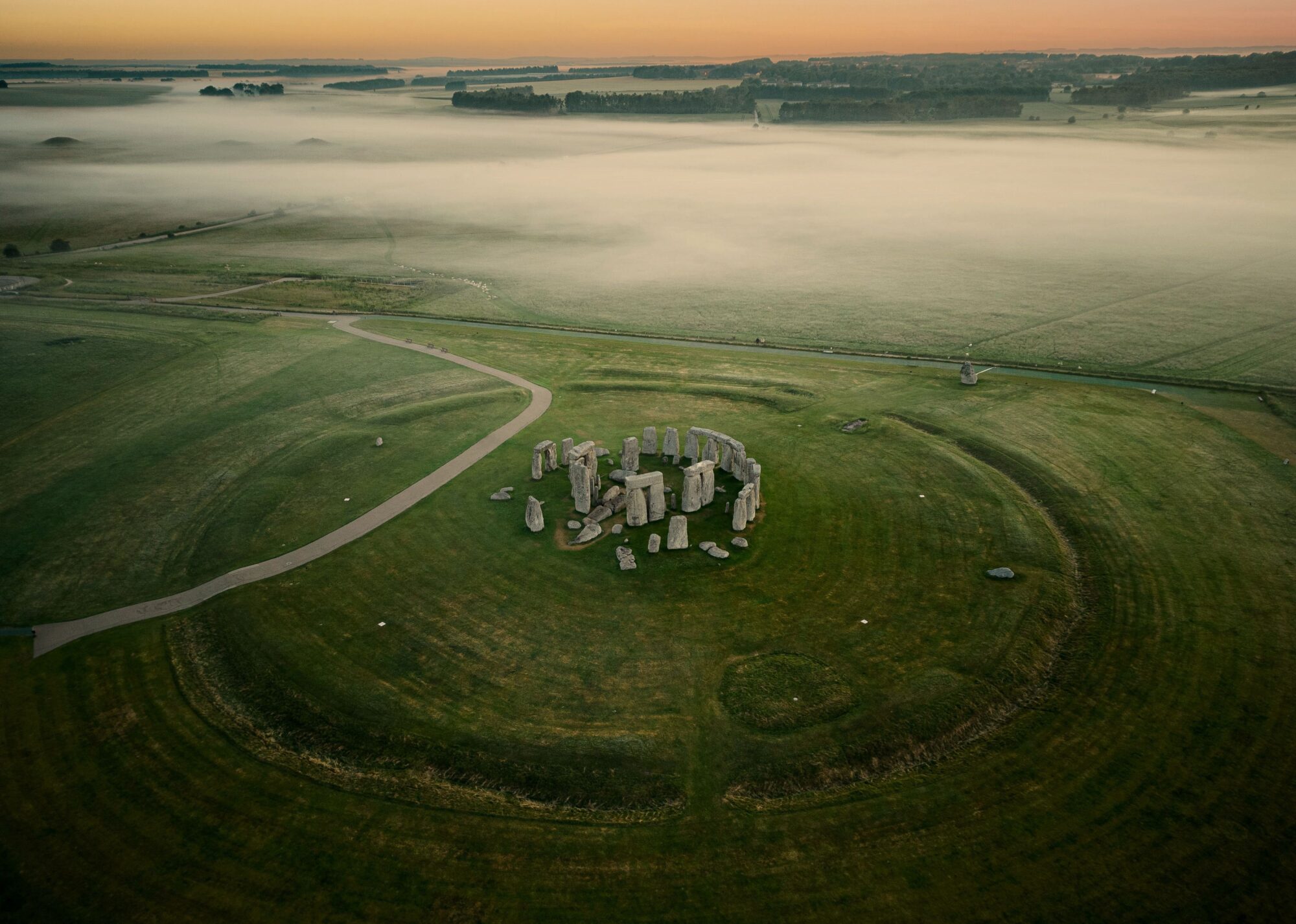Perhaps no other ancient structure has the same level of fame as Stonehenge. There were many phases to the building of Stonehenge. The first was an early henge monument that came about 5,000 years ago. The distinctive stone circle didn’t appear until the late Neolithic period, about 2500 BC. The early Bronze Age saw the construction of numerous burial mounds in the area. As part of a World Heritage Site, Stonehenge and Avebury together house an unparalleled collection of ancient structures.
Table of Contents
ToggleAn Introduction to Stonehenge: the earliest known structure
Between 8500 and 7000 BC, during the Mesolithic era, the first documented constructions in the region are four or five pits, three of which seem to have had enormous pine “totem-pole-like” poles. The connection between these posts and the later Stonehenge structure is unclear.
During a time when woods covered much of southern England, the chalk downland surrounding Stonehenge may have been an unusually open terrain. That may have been the reason it became the location of a Neolithic monument complex so early on.
Robin Hood’s Ball’s causewayed enclosure, the Lesser Cursus, two rectangular earthworks known as cursus monuments, and a number of long barrows were all part of this complex that dates back to the ages about 3500 BC. These structures likely influenced the subsequent placement of Stonehenge.
What was the earliest monument?
Some parts of Stonehenge, like the Heel Stone and the low rock called the North Barrow, may have been there from the beginning. But the first important event that we know of was the digging of a circular ditch with an inner and outer bank around 3000 BC. It had a space with two entrances and a diameter of about 100 meters. The Henge monument was in its early stages.
There were 56 pits, or Aubrey Holes, located immediately within the bank, and there could have been some wooden buildings inside the ditch and bank as well. An old theory that some of these holes may have contained stones has lately made a comeback, challenging the long-held belief that they supported upright wood pillars.
Burial places for ashes were the Aubrey Holes and the ditch. With the discovery of 64 cremations and the possible initial burial of up to 150 people, Stonehenge is the biggest late Neolithic cemetery in the British Isles.
Who constructed Stonehenge?
Scientists have found many hints that point to the builders of the monument. It is possible that some of these individuals resided in the dwellings dug at Durrington Walls, a neighbouring Neolithic community that included a henge, and were therefore close to the monument. Based on artefacts discovered at the site, a 2015 study in the journal Antiquity revealed that the inhabitants of Durrington Walls consumed a lot of meat and dairy products. According to the team’s findings, the individuals who could have constructed Stonehenge were probably not enslaved or forced to eat a special diet.
It is still not known what group the builders of Stonehenge belonged to. Since the construction of Stonehenge occurred before the invention of writing in Britain, it is difficult to determine the exact governmental structure of the island at that time.
Numerous modern-day visitors link the druids, enigmatic ancient British pagan religious figures, with Stonehenge. But druids were most likely not involved in the construction of Stonehenge. The first written reference to druids dates back to 2,400 years, while the site’s construction happened between four thousand and five thousand years ago.
How was Stonehenge constructed?
The mystery has perplexed thinkers for ages, and no satisfactory explanation has emerged in that time. How on earth were these enormous stones organised and carried by humans thousands of years ago?
Legend has it that a magician called Merlin transported the stone circle from its original location on an Irish mountain to England using wizardry. People said the giants built the monument.
Each bluestone weighs almost 3,600 kg, which is equivalent to two vehicles! The larger sarsen stones, on the other hand, weigh an enormous 22 tonnes, which is equivalent to four African elephants! From 32 kilometres distant, archaeologists think, large wooden sledges transported the sarsen stones to the site, while rafts transported the bluestones to Welsh rock outcrops located 225 kilometres away! It was possible to have them pulled by sledges to a stream and then rafted to the construction site.
Hundreds of hours of hard labour with stone hammers and chisels would have been necessary to shape the stones. The question is, how were the massive stones brought to their feet? The builders supposedly started by digging huge trenches to set the stones in. Then, they raised the stones using ropes, sturdy wooden frames, and poles. Finally, they filled the ditches with pebbles and gravel to ensure their stability.
It’s a sacred landscape
The hallowed environment that included Stonehenge also encompassed several additional stone and timber constructions, as well as burial grounds. The area was a Mesolithic hunting refuge in Britain from 11,600 until the end of the Bronze Age, when the monument was still in the planning stages.
Archaeologists have discovered a plethora of important ancient buildings at or around Stonehenge. These include tombs and burial mounds, shrines (some circular in form), and a “House of the Dead” that contains hundreds of corpses from 3700 B.C.
“Cursus” monuments, two rectangular earthworks constructed about 3500 B.C., were also located north of the site that would later be Stonehenge, according to English Heritage.
Here is where ancient astronauts have docked
In 1968, Erich von Däniken published Chariots of the Gods, which brought this theory to a wider audience by speculating that aliens may have constructed Stonehenge and other ancient sites. The “interpretations” of Mayan iconography and other enigmatic global sites, like the Nazca Lines, form the basis of his argument.
There is a connection between monoliths and stone circles and alien life that lives on other planets. For instance, Stanley Kubrick’s adaptation of Arthur C. Clarke’s 2001: A Space Odyssey links the mysterious monolith to aliens, as does the stone circle of Milbury in the 1970s children’s TV show Children of the Stones, which filmed in Avebury, Stonehenge’s sister site.
How to Visit Stonehenge?
The Stonehenge is in Wiltshire’s Amesbury. It is an ideal complement to any two-week England itinerary, and it is located around 80 miles west of London. Both the car and the train from London will take around 1.5 hours. Because of its proximity to the capital, visiting Stonehenge is a breeze for a day excursion.
Another option is to extend your stay for a weekend and see the surrounding towns, such as Salisbury and Bath. Whether you’re planning an international vacation, a working trip, or just a vacation to the UK, we think you shouldn’t miss this place. No trip to England is complete without seeing this—we hope you understood.
Travel options
Day trips to Stonehenge are easy to arrange in a variety of ways. Because we believe it is the easiest choice, we suggest that you book a bus excursion. In addition to the admission charge and transportation to and from Stonehenge, your ticket also includes transportation home. However, another option is to hire a vehicle and drive there on your own, following the A303 roads after the M3.
First-time UK drivers seem overwhelmed at first, but they quickly adapt to the roads and traffic! Additionally, the Stonehenge Tour Bus will drop you off at the Visitor Centre from Salisbury train station, where you may also board the train.
Plan your trip to Stonehenge. What should you do there? How long should you stay?
At Stonehenge, there are really only two things to do. Start by going to Stonehenge, where you may snap as many pictures as you like while admiring the stones. Indeed, the stroll is captivating. They built a parking lot and tourist centre at Stonehenge because of how popular it was. Building these facilities on the other side of the highway from Stonehenge was essential to handle the large number of tourists.
Stonehenge is accessible by foot via a tunnel beneath the roadway, which is around one and a half kilometres (1.6 km). If you want to take it easy, a shuttle bus departs every five minutes. The good news is that when you emerge from the tunnel, you won’t be disappointed.
Make sure you purchase your Stonehenge ticket in advance
Guests may now purchase tickets at Stonehenge using a time-entry system. So, you have to make an appointment request if you want to get in. From 8:30 in the morning to 5:00 in the afternoon, it is open for business. If you want to escape the crowds, the best times to visit are just after the site opens at 10 a.m. or between 3 and 4 p.m. This recommendation takes on an even greater significance during the summer, when the location experiences a surge of visitors.
At the moment, adults may get in for £23.30 and children can pay £11.40. Additionally, there is a £5 parking charge during busy periods. You might also anticipate paying a few more pounds if you show up unannounced. To skip the lines and reserve a time and ticket in advance, visit the English Heritage website.




